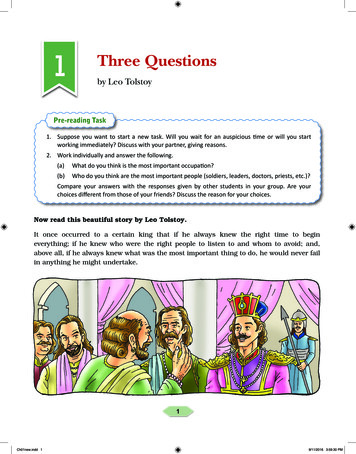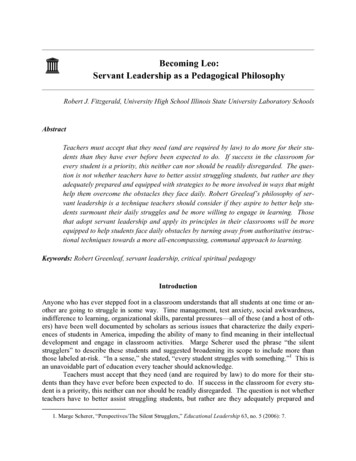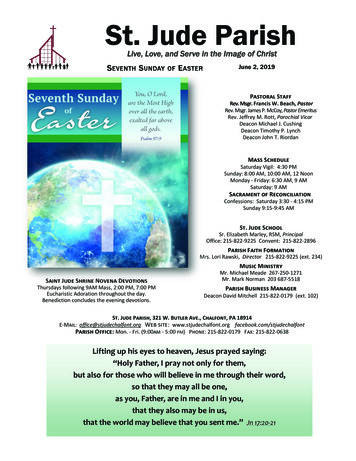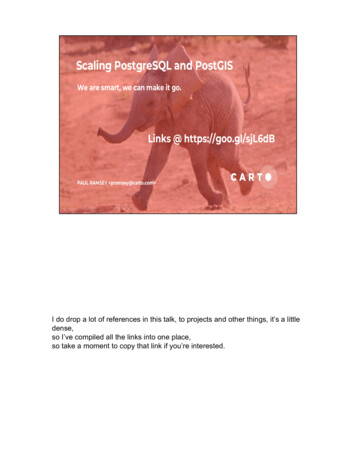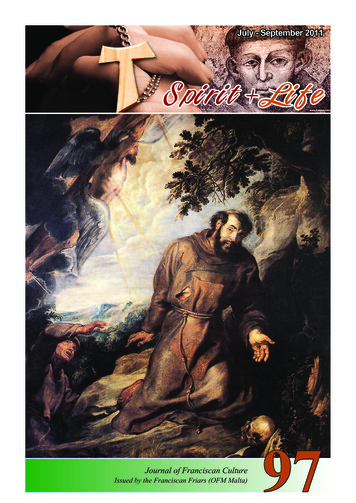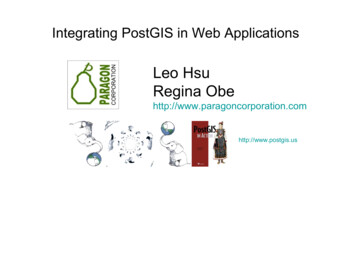
Transcription
Integrating PostGIS in Web ApplicationsLeo HsuRegina tgis.us
What we will be covering Links and Relevant Ecosystem of Open Source GIS andOpenGIS Glossary of Terms Tools to Load/Extract spatial data from PostGIS Proximity Queries with PostGIS 1.5 OpenLayers Using OpenStreetMap as a base layer on a map Using WMS Layers in OpenLayers Geoserver and MapServer Publishing PostGIS data with WMS Publishing PostGIS data with WFS Roll your own custom layers using PostGIS output functions Enhancing OpenLayers with GeoExt
Links and Relevant Ecosystem of Open Source GIS http://www.postgis.org PostGIS Website: (its now an OSGEO incubation project)http://trac.osgeo.org/postgis PostGIS community and bug tracker. Also contains user contributed code snippets, tips, and links.http://www.osgeo.org/ OSGEO – Open Source Geospatial Foundation, provides hosting and other resources to the Open Source GIS community andOSGEO projects.http://postgisonline.org PostGIS Online – work in progress started by Nicklas Avén, one of the core PostGIS developers. It allows you to experimentwith PostGIS spatial queries in a database sandbox. Uses Mapserver for displaying query on a map. Also has some step by step tutorials.http://openlayers.org OpenLayers – Javascript Framework we’ll be demonstrating. Was started by MetaCarta, a local Cambridge,MA company and later becamean OSGEO project. BSD style license.http://geoserver.org GeoServer – a Java Servlet written web mapping server we’ll be covering and is also an OSGEO incubation project. GPL licensed.http://www.mapserver.org/ MapServer - a C written web mapping server. The first OSGEO project and also the first mapping server to support PostGIS. MITstyle licensed. http://www.codeplex.com/SharpMap - both a web and desktop mapping toolkit written in C#. Used often to create ASP.Net and more recentlySilverlight apps. PostGIS was one of the first data sources it supported. LGPL licensed. http://geoext.org – GeoExt is a mapping javascript toolkit that combines the power of OpenLayers for mapping and ExtJs for general Rich Internet Application (RIA)building. Its BSD licensed.http://www.extjs.com – A very popular javascript framework for building RIA. Comes packaged with various graphical widgets that can be stretched, moved onscreen etc. http://www.opengeospatial.org/ Open Geospatial Consortium (OGC) standards making body for geospatial and location based services. Most of thehigh end GIS vendors are on the committee as well as many open source GIS members. It tries to improve ease of interoperability between the varioustool sets.OUR SATELLITE SITES http://www.postgis.us – PostGIS in Action book site – contains code downloads, eventually demos of what is in book, presentations we’ve done, useful PostGISlinks.We are co-authors of the upcoming Manning book, PostGIS in Action, due out in hard-copy in Summer 2010. You can purchase now via the Manning EarlyAccess Program (MEAP) and read chapters as we complete/update them. First chapter is a free download. Have almost all the chapters complete and on MEAP. http://www.bostongis.com – BostonGIS.com is focused on Open Source and Open Geospatial standard tips and tricks. http://www.postgresonline.com – Postgres OnLine Journal is focused on providing a resource for PostgreSQL users and newcomers by providing examples thatdemonstrate PostgreSQL’s unique features, and how to use PostgreSQL effectively. Each edition available as free PDF. We try to release monthly/bi-monthly.
Glossary Of Terms EPSG – European Petroleum Survey Group – they are the authority for a lot of the spatial reference systems used today.In SRS you’ll see their initials prefixed EPSGESRI Shapefile – kind of the defacto standard of data transporting for GIS. Pretty much every GIS desktop tool and Opensource GIS desktop tool, loaders etc support it. Most vector spatial data you can download is in this format. Created byEnvironmental Systems Research Institute (ESRI) which is the big bad fish vendor in the GIS world. It has a .shp/.shx tostore the geometry part and a dbf to store the regular attribute data.GeoJSON – http://geojson.org/ Geography Javascript Object Notation. New standard. In OGC draft spec. Combines JSONserialization of attribute and adds to it how geometry objects should be serialized as JSON.GEOS – Geometry Engine Open Source – the engine used for many of PostGIS advanced functions. C based.GML – Geography Markup Language. A data transport XML format standard of OGC often used to output WFS requestsKML – Keyhole Markup Language – another XML standard that includes stylistic features, popularized by Google, andlater adopted as a transport standard by OGC.OGC – Open Geospatial Consortium – standards body for Geospatial interoparability between productsOSGEO – Open source Geospatial Foundation – incubator of many open source projects including PostGIS and GEOSSRID – Spatial Reference Identifier – this is the primary key (usually a number) in a spatial reference system catalog ofoptions. It is common terminology for OGC spatial databases.SRS (ID) – Spatial Reference System. This is similar in concept to spatial database SRID. It defines the coordinatesystem, projection, and datum of spatial data. Most common ones you’ll see are EPSG:4326 (WGS 84 long lat),EPSG:3875 (Web Mercator), EPSG:900913 (Web Mercator old SRS before Web Mercator became a EPSGstandard). In fact PostGIS loaded list of SRIDS have just the numbers 4326, 3875, etc. WGS – World Geodetic System standard for defining geodetic data, ellipsoid and geoid models that is the foundation ofmany spatial reference system. Long Lat data using a reference ellipsoid. Common one used is in WGS 1984.WFS – Web Feature Service – another web mapping standard created by OGC for outputting vector and attribute data.WMS – Web Mapping Service – one of the standards defined by OGC
Open Source Tools to Load Data and Extract Datashp2pgsqlCommand line data loader packaged with PostGISImports standard ESRI Shapefiles and DBFs* into PostGIS geometry/geographyshp2pgsql-guiGTK based Graphical user interface data loader with more or less same functionalityas the command line loader. Also packaged with PostGIS 1.5.0 . Note: Not prepackaged with all distributions so you may need to compile yourself. Available forwindows distributions via StackBuilder.pgsql2shpCommand line tool packaged with PostGIS that allows you to export spatial tablesand ad-hoc queries to ESRI Shape file formatOGR2OGR/GDAL http://fwtools.maptools.org/Open source tool packaged in FWToolsImports 20 different vector and flat file formats and various raster formats. Drivercurrently being developed to load into new PostGIS WKT Raster type.Spatial Data Integrator http://www.spatialdataintegrator.com/ETL tool with geospatial capabilities and graphical workbench. It is based on Talend OpenStudio.Geokettle http://sourceforge.net/projects/geokettle/This is the geospatial equivalent of Pentaho Data Integration (Kettle). Supports out of thebox PostGIS, Oracle Spatial, MySQL, ESRI Shapefiles. It can run as a web service.
Where to get Free DataWorld OpenStreetMap – http://www.openstreetmap.org is a community driven spatialdatabase and map repository of road networks, bike trails, etc. that recentlyswitched to using PostgreSQL for their back-end. It uses public domain datasourced from various governments and non-profits and enhanced by communityeditors. They have a tool called OSM2pgsql that you can use to load up their datainto your PostGIS enabled database - http://wiki.openstreetmap.org/wiki/Osm2pgsql Geocommons - http://finder.geocommons.com/ available in various formats oftenincluding ESRI Shapefile and KMLUnited States .gov – just recently launched and has both GIS as well as nonGIS data. If you are interested about your own state – check out the map ofstates that have launched their own open gov ts, our home state is on the list, and has tons and tons of free GIS data includingspectacular satellite imagery available for download or via their numerous web services.Canada GeoBase: http://www.geobase.caStatistics Canada: .cfmNatural Resources Canada http://geogratis.cgdi.gc.ca/
Simple Web IntegrationProximity Analysis PostGIS Geography introduced in 1.5GIST index on your geography columnST DWithin functionSome long lat dataSupported All core geometry types –(MULTI) POINT, LINESTRING, POLYGON,Geometry Collections – WGS 84 long lat Measurements always returned in meters
Simple Web IntegrationSample Proximity Query What does a geography spatial proximity querylook like: lat 43.66596; lon -73.13868; pt "ST GeogFromText('SRID 4326;POINT( lon lat)') "; miles 300; sql "SELECT full name, lfromadd, ltoaddFROM edgesWHERE ST DWithin(edges.geog, pt,1609* miles)ORDER BY ST Distance(edges.geog, pt) LIMIT 20"; Will return closest 20 streets within 300 miles of a point.
Real World ApplicationSimple Integrationhttp://www.photographers.com/Find the nearest photographers to you Uses new PostGIS geography format Visitors tagged with GeoIP and showsphotographers ordered by GeoIP proximity tovisitor PostgreSQL backend PostGIS geography type to store locations of photographers PostgreSQL triggers to keep geography location consistent with input address ofphotographers. PHP and JQuery front end.
OpenLayers JavaScript Framework Fairly easy to use Javascript Web Mapping Numerous Mapping drivers (OGC – WMS,WFS, WFS-T) Supports Proprietary – Google, Bing, Yahoomaps, ArcGIS Rest, ArcGIS IMS, etc. OGC transport vector formats – GML,GeoJSON, KML You can overlay all on a single map
OpenLayers Highly CustomizedUses PostgreSQL/PostGIS backend for storing vector and user input data. Own customized tile server builtwith Java. Geoserver for WFS and WFS-T (vector/attribute data editing)
OpenLayers Plain VanillaWhat does it look like?
OpenLayersWhat does the code look like? html head title OpenStreetMap Boston /title script src "js/ol28/OpenLayers.js" /script script src tMap.js" /script script src "http://api.maps.yahoo.com/ajaxymap?v 3.0&appid postgisus" /script script src .ashx?v 6.2' /script script type "text/javascript" Map setup and init code here /script /head body !-- define a DIVs for map and legend -- table tr td div style "width:700; height:600" id "map" / /td td valign "top" div id "legend" / /td /tr /table script type "text/javascript" defer "true" init(); /script /body /html
OpenLayersMap Setup Code script type "text/javascript" var lat 42.35815;var lon -71.05971;var zoom 15;var map; //complex object of type OpenLayers.Mapfunction init() {map new OpenLayers.Map ("map", {controls:[ new OpenLayers.Control.Navigation(),new OpenLayers.Control.PanZoomBar(),new OpenLayers.Control.LayerSwitcher(),new OpenLayers.Control.Attribution(),new OpenLayers.Control.MousePosition()],maxExtent: new OpenLayers.Bounds(-8879149, 4938750,-7453286, 6017794),maxResolution: 156543.0399,numZoomLevels: 20,units: 'm',projection: new tion: new OpenLayers.Projection("EPSG:4326")} );var lyrMapnik new OpenLayers.Layer.OSM.Mapnik("OSM Mapnik");var lyryahoohyb new OpenLayers.Layer.Yahoo("Yahoo Hybrid",{'type': YAHOO MAP HYB, 'sphericalMercator': true});var lyrbing new OpenLayers.Layer.VirtualEarth("Bing",{'type': VEMapStyle.Hybrid, 'sphericalMercator': true});map.addLayers([lyrMapnik, lyryahoohyb, lyrbing])if( ! map.getCenter() ){var lonLat new OpenLayers.LonLat(lon, lat).transform(new OpenLayers.Projection("EPSG:4326"), map.getProjectionObject());map.setCenter (lonLat, zoom);}} /script
Web Mapping Service (WMS) Dishes out images of requested sections of geographic data as images (RASTER) evenwhen data is of a vector nature Many commercial ones Many Open source ones – Some common ones that work with PostGIS MapServer - http://mapserver.org/ (Written in C. Most often run as a CGI) GeoServer - http://geoserver.org (Written in Java/Java Servlets) SharpMap.NET - http://sharpmap.codeplex.com/documentation(Written in C#. It has WMS 1.3 capabilities but is more designed for more intimate integrationwith .NET Framework and Silverlight) Data sources generally supported by WMS RASTER – e.g. Aerial photos (JPEG,GeoTiff, MrSID etc.) – sometimes stored in database Vector data Flat file -- e.g ESRI Shapefile, MapInfo tab, and others Vector data OGC Spatial Enabled Database – PostgreSQL/PostGIS SQL Server 2008 SpatiaLite (the spatially enabled SQLite which also uses GEOS similar to PostGIS) ESRI ArcSDE (PostgreSQL SDE, SQL Server SDE,Oracle SDE) Oracle Locator/Spatial DB2 or Informix Spatial DataBlade Cough cough – even sometimes MySQL
Web Mapping Service (WMS)What makes up a call MassGIS site explaining these (in our Hometown) –http://lyceum.massgis.state.ma.us/wiki/doku.php Latest WMS standard is 1.3, but most tools only support 1.1.1 Three main kinds of WMS calls: REQUEST type of request GetCapabilities – Provides a catalog of what map layers the service offersand what projections supported in XML format.There are sometimes required SERVICE and VERSION arguments. These are not requiredfor services that only support one protocol or geoserver/wms?REQUEST GetCapabilities&VERSION 1.1.1 GetMap – Dishes out an image of a particular region BBOX – bounding box e.g: BBOX -8057798.50,5106032.31,-7765426.87,5319750.24 SRS – the spatial reference system (which in 1.3 is CRS) – SRS EPSG:900913 (old web mercator) – newequivalent would be SRS EPSG:3785 SERVICE/VERSION (if service provides more than one) – SERVICE WMS&VERSION 1.1.1 LAYERS – a comma separated list of layers to show FORMAT – image format – FORMAT image/png WIDTH – width of tile to return in pixels WIDTH 500 HEIGHT – height of tile to return in pixels HEIGHT 500 STYLES – A comma separated list of names of styles supported by the layers selected SLD – URL to a style layer descriptor for more advanced styling SLD BODY – a fully xml style layer descriptor documentGetFeatureInfo – usually plain text or GML describing a particular feature. Used to display info about an item whensomeone clicks on a map. WFS can be used instead too. GetLegendGraphic – call to get legend image to show for a layer LAYER FORMAT WIDTH HEIGHT
Web Mapping Service (WMS) Adding a WMS to OpenLayers script type "text/javascript" var lat 42.3572;var lon -71.01365;var zoom 13;var map; //complex object of type OpenLayers.Mapfunction init() {map new OpenLayers.Map ("map", {controls:[ new OpenLayers.Control.Navigation(),new OpenLayers.Control.PanZoomBar(),new OpenLayers.Control.LayerSwitcher(),new OpenLayers.Control.Attribution(), new OpenLayers.Control.MousePosition()],maxExtent: new OpenLayers.Bounds(-8879149, 4938750,-7453286, 6017794),maxResolution: 156543.0399,numZoomLevels: 20,units: 'm',projection: new tion: new OpenLayers.Projection("EPSG:4326")} );var lyrMapnik new OpenLayers.Layer.OSM.Mapnik("OSM Mapnik");var lyryahoohyb new OpenLayers.Layer.Yahoo("Yahoo Hybrid",{'type': YAHOO MAP HYB, 'sphericalMercator': true});var lyrbing new OpenLayers.Layer.VirtualEarth("Bing",{'type': VEMapStyle.Hybrid, 'sphericalMercator': true});map.addLayers([lyrMapnik, lyryahoohyb, lyrbing])map.addLayer(new OpenLayers.Layer.WMS("MassGIS: Water and Light", er/wms",{ 'layers': "massgis:GISDATA.LIGHTHOUSES PT,massgis:GISDATA.FERRYROUTES ARC,massgis:GISDATA.WATERTAXISTOPS PT",'transparent': "true", 'FORMAT': "image/png"},{ 'isBaseLayer': false, 'visibility': true, 'buffer': 1, 'singleTile':false, 'tileSize': new OpenLayers.Size(200,200),,'attribution':' br / Water and Light a href "http://lyceum.massgis.state.ma.us/wiki/doku.php" MassGIS EEOC Webservices /a ' })); ('legend').innerHTML 'Layers from MassGIS (EEOA) br / img src er/wms/GetLegendGraphic?VERSION 1.0.0&FORMAT image/png&WIDTH 20&HEIGHT 20&LAYER massgis:GISDATA.LIGHTHOUSES PT" / br / ' 'Ferry Routes: img src er/wms/GetLegendGraphic?VERSION 1.0.0&FORMAT image/png&WIDTH 20&HEIGHT 20&LAYER massgis:GISDATA.FERRYROUTES ARC" / br / ' 'Water taxis: img src er/wms/GetLegendGraphic?VERSION 1.0.0&FORMAT image/png&WIDTH 20&HEIGHT 20&LAYER massgis:GISDATA.WATERTAXISTOPS PT" / ';if( ! map.getCenter() ){var lonLat new OpenLayers.LonLat(lon, lat).transform(new OpenLayers.Projection("EPSG:4326"), map.getProjectionObject());map.setCenter (lonLat, zoom);}} /script
Web Mapping Service (WMS) Adding a WMS to OpenLayers
Web Feature Service (WFS) Dishes out vector attribute data usually in the form of GML, GeoJSON, or KML Allows for easier client side styling since vector data and attribute data is past as text. Many commercial ones Many Open source ones – most commonly used that work with PostGIS MapServer - http://mapserver.org/ (supports plain WFS for readonly querying) GeoServer - http://geoserver.org (supports both WFS and WFS-T (the transactional for editing layers)) TinyOWS - http://www.tinyows.org (supports both WFS and WFS-T, but not WMS) requires PostGIS 1.5 Runs as CGI similar to MapServer so often used to provide the WFS-T component that MapServer lacks FeatureServer – sort of OGC can understand OGC WFS lingo but has its own more common RESTFulway of doing things. Written in Python. BSD style license. Brought to us by MetaCarta.The same folks that gave us open layers. Data sources generally supported by WFS Vector data Flat file -- e.g ESRI Shapefile, MapInfo tab, and others Vector data OGC Spatial Enabled Database – PostgreSQL/PostGIS SQL Server 2008 ESRI ArcSDE (PostgreSQL SDE, SQL Server SDE,Oracle SDE) Oracle Locator/Spatial DB2 or Informix Spatial DataBlade Cough cough – even sometimes MySQL Main Caveat – usually require a proxy if you are trying to access a WFS server via javascriptand WFS not coming from your webdomain. HTML5 standards supports cross-domain to make this probably not necessary.
MassGIS site explains this tooWeb Feature Service (WFS)What makes up a hp?id filter functions Latest WFS standard is 1.1.0, but most people are running 1.0.0 - http://www.opengeospatial.org/standards/wfs Main difference between WFS and WMS is that WFS allows for more advanced queries using spatial filters and usually returns data in somevector or XML format while WMS is more designed for returning data as images. Three main kinds of WFS calls: REQUEST type of request GetCapabilities – Provides an XML catalog of what spatial layers the service offersand spatial reference system supported, and spatial operators, functions, and output formats supports.There are sometimes required SERVICE and VERSION arguments. Most services that only support one service or version allow you toget away without specifying server/wfs?REQUEST GetCapabilities&VERSION 1.1.0 DescribeFeatureType – Gives you list of attributes (table columns) and data types of a feature type table. Need a type name or list of typenames separated by oserver/wfs?REQUEST DescribeFeatureType&TypeName massgis:EOPS.UCR 85 S V,massgis:GISGetFeature – Dishes the data about a particular feature or set of features usually in GML format BBOX – bounding box e.g: BBOX -8057798.50,5106032.31,-7765426.87,5319750.24 SRS – New in 1.1.0 I think (older versions of WFS you were stuck with whatever the default was) SERVICE/VERSION (if service provides more than one) – SERVICE WFS&VERSION 1.1.0 TYPENAME – a comma separated list of layers (feature types) to show FORMAT – Defaults to GML if not specified PROPERTYNAME – ), etc. (optional will return all columns if not specified) FILTER - Too complex to get into MAXFEATURES – max number of features to return
But I want to display my own dataDisplaying PostGIS Layers (queries)Many Options to Choose From Roll your own with web scripting language and output functions:ST AsGML, ST AsGeoJSON, ST AsKML, ST AsBinary, ST AsText Toolkits SharpMap.NET, GeoDjango, etc. Use Web Mapping Service (WMS) which dishes out image tiles Use Web Feature Service (WFS)dishes out data in vector form usually as some sort of XML streamUsually Geography Markup Language (GML) For added speed, a web caching service such as TileCache or GeoWebCacheto cache frequently requested tiles reduce roundtrips to database. These sit in frontof WMS and generally have a WMS interface.
GeoserverIt is a very functional and fast Mapping serverwith A FANCY SMANCY ADMINISTRATIVE CONSOLE.It is a Ferrari that doesn’t cost Ferrari prices. Java Servlet based that can run using the packaged Jetty web server Latest version 2.0.1 It can also run under other servers using Tomcat Servlet plugin for Apache or IIS Works on most any OS GNU GPL licensed Open Source Can compile your own or download binaries from http://geoserver.org/display/GEOS/Download Great tutorial by Paul Ramsey http://demo.cleverelephant.ca/ pramsey/oss-geostack-intro/doc/en/geoserver.html Supports OGC standard interfaces WMS, WFS, WCS Supports Common Query Lanaguage (CQL) filters for WMS and WFS Supports Style Layer Definitions (SLD) – an OGC XML standard for defining styles (colors to code etc.) Also WFS-T (which is lacking in Mapserver) Oodles of formats supported can display Its WFS can output to not only GML, but also GeoJSON, KML, and ESRI Shapefile PostGIS native driver
GeoServer Fancy SmancyAdministrative Console
GeoServer: Creating PostGIS Store1. Create a workspace2. Add a new datasource3. Choose PostGIS4. Fill in Info5. 3-4 For eachPostgreSQL schemayou have with spatialdata
GeoServer: Publishing PostGIS Layers1.2.3.4.5.6.7.Choose LayersAdd a new ResourceSelect your data storePublish a layer (PostgreSQL Table)Fill in meta dataClick compute bounding boxes from data1-6 Repeat for each layer
GeoServer: See the layers in WMS/WFS1.2.Click Layer PreviewMany output formats clicking OpenLayers will show you anautogenerated map with your layer
Mapserver – Doesn’t need to be huggedIt is a very functional and fast Mapserverwith no fancy smancy administrative consoleIt is THE MapserverDoesn’t need a nice comfy bed to lay on like GeoServerJust throw a mat on the floor CGI/FastCGI exe for those who want immediate productivity Latest version 5.6.2 just released PHP Mapscript / Python MapScript / .NET mapscript and other Mapscriptsfor more granular control but requires you do a lot of the plumbing yourself Works on most any OS and most any web server (APACHE,IIS, Light whatever) BSD style license Can compile your own or download binaries from http://mapserver.org/download.html#binaries If you want to use CSharp Mapscript (which really can be used in any .NET language)We suggest FWTools build which contains a csharp folder containing the interop extensions. Has its own non OGC standard interface Also supports OGC standard interfaces WMS, WFS, WCS etc. including new WMS 1.3.0 standard Oodles of formats supported with a pluggable format architecture for registering additional plugins PostGIS native driver built-in and in fact the very first mapping server to support PostGIS Supports queries as layers We’ll focus on its OGC functionality
Mapserver5 Things you should knowFor WMS/WFS, all you need to create is a .map file5 important things to know about map files1. In mapserver 6.0 – mapfile will support new Mapserver XML format natively2. Mapserver 5.6 there is an XML standard and xsd as well as an xsl to convert to standard MapServermap file format1. If you have password sensitive info in your map, make sure your password info is not accessible via http:Number of ways of doing this Can keep mapfile out of the web root Keep password sensitive info in an include that is never dished out Encrypt passwords with msencrypt executable packaged with mapserver Via your Apache or IIS config – set .map files to not be dished out1. Need to add wfs/wms/ows meta data options for it to behave like a proper WMS/WFS service2. You can have INCLUDES pretty much anywhere in the map file.
Mapserver Mapfile for WMS/WFSMAPINCLUDE "config.inc.map"NAME "POSTGIS IN ACTION" #name to give your map service# This is the extent of your map in the srs units of mapEXTENT 221238 881125 246486 910582UNITS meters# Default projection of your map - all layers in different# projection will be reprojected to thisPROJECTION"init epsg:26986"ENDWEBMINSCALEDENOM 100MAXSCALEDENOM 100000METADATAows title "PostGIS in Action Chapter 11"ows onlineresource "http://www.postgis.us/demo/chapter 11/GetPAMap.ashx?"wms version "1.1.1"wms srs"EPSG:2249 EPSG:4326 EPSG:26986 EPSG:3785 EPSG:900913"wfs version "1.0.0"wfs srs"EPSG:26986"ENDEND #End WebINCLUDE "layers.inc.map"END # Map File
Mapfile Includesconfig.inc.mapCONFIG PROJ LIB "/path/to/proj lib"SYMBOLSET "symbols/postgis in action.sym"FONTSET TYPE POSTGISCONNECTION "host localhost dbname somedb user someuser port 5434 password somepassword"PROCESSING "CLOSE CONNECTION DEFER"
Mapfile PostGIS LayersLAYERNAME hospitalsTYPE POINTSTATUS ONDUMP TRUEINCLUDE "postgis.config"DATA "geom from ch11.ma hospitals using unique gid using srid 26986"METADATAows title "Massachusetts Hospitals"gml include items "all"wfs include items "all"ows featureid "gid"ENDCLASSSYMBOL 'circle'EXPRESSION ('[trauma]' 'Y')SIZE 10COLOR 255 0 0ENDCLASSSYMBOL 'circle'EXPRESSION ('[trauma]' 'N')COLOR 0 200 100SIZE 10ENDLAYERNAME openspaceTYPE POLYGONSTATUS ONDUMP TRUEINCLUDE "postgis.config"DATA "geom from ch11.ma openspace using unique gid using srid 26986"PROJECTION"init epsg:26986"ENDMETADATAows title "Massachusetts OpenSpace"gml include items "all"ows featureid "gid"wms srs "EPSG:2249 EPSG:4269 EPSG:4326 EPSG:26986 EPSG:3785 EPSG:900913"ENDOPACITY 70CLASSCOLOR 153 0 102OVERLAYCOLOR 102 102 0OVERLAYOUTLINECOLOR 200 0 0ENDENDLAYERNAME major roadsTYPE LINESTATUS ONDUMP TRUEINCLUDE "postgis.config"DATA "geom from ch11.ma eotmajroads using unique gid using srid 26986"PROJECTION"init epsg:26986"ENDLABELITEM "rt number"METADATAows title "Massachusetts Major Roads"gml include items "all"ows featureid "gid"ENDCLASSCOLOR 255 0 0LABELTYPE truetypeFONT arialMINDISTANCE 50POSITION AUTOANGLE AUTOSIZE 6COLOR 0 0 0ENDENDLAYERNAME hospitals anotTYPE ANNOTATIONSTATUS OFFDUMP TRUEINCLUDE "postgis.config"DATA "geom from ch11.ma hospitals using unique gid using srid 26986"METADATAows title "Massachusetts Hospitals"gml include items "all"wfs include items "all"ows featureid "gid"ENDLABELITEM shortnameCLASSCOLOR 255 0 0LABELTYPE truetypeFONT arialMINDISTANCE 50POSITION AUTOSIZE 6COLOR 0 0 0ENDENDEND
How do you call Mapserver as aWFS/WMS Service?1. Need to call the cgi executable with map physical path to map file2. Rest of arguments you pass are pretty much the standard OGC WFS/WMS callsExamples:Get ?map C:/mapserv/maps/postgis in action.map&SERVICE WMS&VERSION 1.1.1&REQUEST GetCapabilitiesEtc.Etc.
Wrap your Mapserver in aReverse ProxyThe ugly and annoying truths about Mapserver Map file paths can get very long and ugly, particularly on windows. If you do development on one computer and upload to the other have to change allyour code to go to absolute paths. Again very annoying.Alternatives Solution – either write a CGI wrapper such as described herehttp://mapserver.org/cgi/wrapper.html Write a regular page or handler in ASP.NET, PHP, stuff your favorite web languagehere that calls your mapserv with the right map file and maybe also WMS andVERSION.The wrap in a proxy has many advantages over just a CGI wrappera) Your mapserv CGI bin doesn’t need to be on the same server as your web server,though your web server needs to be able to call it by HTTP.b) You can use it to call other services – e.g a Government Web service and getaround the cross domain scripting issues of HTML4 when calling WFS.c) You can use it for load balancing. Maps are more intensive to produce than otherweb pages – if you have millions of hits you may want to redirect to various serversand add more servers as needed.
ASP.NET Reverse Proxy (VB.NET) %@ WebHandler Language "VB" Class "GetPAMap" % Imports SystemImports System.WebPublic Class GetPAMap : Implements IHttpHandlerPublic Sub ProcessRequest(ByVal context As HttpContext) Implements IHttpHandler.ProcessRequestDim mapURLStub As String "http://" context.Request.ServerVariables("HTTP HOST") "/mapservbin/mapserv.exe?map "Dim mapfile As String "c:/mapserver/maps/postgis in action.map"Dim WebRequestObject As System.Net.HttpWebRequestDim sr As System.IO.StreamReaderDim WebResponseObject As System.Net.HttpWebResponseDim sb As New System.Text.StringBuilder()Dim key As Stringsb.Append(mapURLStub mapfile)TryFor Each key In context.Request.QueryString.AllKeyssb.Append("&" key " " ng(key)))NextWebRequestObject g()), System.Net.HttpWebRequest)WebRequestObject.Method "GET"WebResponseObject DirectCast(WebRequestObject.GetResponse(), System.Net.HttpWebResponse)If context.Request("REQUEST").ToString.ToLower() "getcapabilities"orElse context.Request("REQUEST").T
OGC - Open Geospatial Consortium - standards body for Geospatial interoparability between products OSGEO - Open source Geospatial Foundation - incubator of many open source projects including PostGIS and GEOS SRID - Spatial Reference Identifier - this is the primary key (usually a number) in a spatial reference system .


